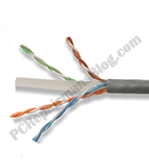I am often asked “what are the differences between Cat 5 and Cat 6 network cable?”. Here’s my take on it:
Physical differences between Cat 5 and Cat 6 network cable
 The main physical differences between these cables is the way in which the spacing inside the cable is maintained. By spacing, I mean that between the pairs of copper wires there is a physical divider. This is most often made of a flexible plastic and it’s like a ‘plus’ sign in cross-section, running down the center of the cable with the 4 cable pairs separated into each quadrant. In a few cases there is foil wrapping used and separation is done with a braided sheath.
The main physical differences between these cables is the way in which the spacing inside the cable is maintained. By spacing, I mean that between the pairs of copper wires there is a physical divider. This is most often made of a flexible plastic and it’s like a ‘plus’ sign in cross-section, running down the center of the cable with the 4 cable pairs separated into each quadrant. In a few cases there is foil wrapping used and separation is done with a braided sheath.
The idea behind this separation is that it reduces “crosstalk” between cables hence the data packets are not lost and speed of transfer is improved.
Cat 5 and 6 bandwidth rating
Category 5 cables are rated at 100 MHz, Category 6 cables are rated at 250 MHz. This effectively means you could push 2.5 times the amount of data down them but in the real world this is not always the case as there are a few other factors that come into play. Category 6 cabling does support the bi-directional transmission that we see in Gigabit Ethernet setups aka 1000BASE-T (1 gigabit is 1000 megabits per second!).
Signal-to-noise ratio performance advantages
Cat 6 cable provides a SNR (Signal To Noise) ratio that is approx 15 times better than Cat 5 cable over a large range of frequencies and compensates well for external ‘noise’ and temperature variations.
Popular applications for network cabling
Cat 6 has much better support for HD video, coping well with HD-SDI which demands up to 1.5 Gigabits per second. It can be used in any application that requires Cat 5 cabling such as till data, PC networks etc, so replacement of older Cat 5 cabling can be done with this newer cable as the end connectors (RJ45) are the same. Do read my next paragraph for a caveat though.
Using Cat 6 cable with Cat 5 RJ45 plugs
The cabling is easy to terminate but watch out for the end connectors. Cat 5 RJ45 connectors are NOT the same as Cat 6 RJ45 connectors. This is a common mistake made by electrical wholesalers and even some suppliers. They don’t know the difference and often brand the end terminations as suitable for both Cat 5 and Cat 6 cabling. You won’t be able to fit Cat 6 into the old connectors because the inner cable diameter is usually that bit bigger. Stripping off the outer sheathing may help temporarily if you are in a fix, but this will usually break the integrity of the end connector as the plastic sheathing also helps to prevent the cable from pulling out. Before attempting a network installation, do a test run with your cable and end terminations. The RJ45 plug will, however, fit in exactly the same socket so no need to change the wall plate, switch, hub, or device socket.
Ready made cables will definitely help the beginner out there as the connections are already made and there is often a moulded boot in place to support the cable and prevent excessive loads from pulling it out. Prices are often as cheap as making your own so go for these unless you need extra long lengths.
Hope this helps to straighten out the lack of information out there, please leave me a comment if you find this helpful.

Wow! This is great I learned something in your post. I am so thankful.